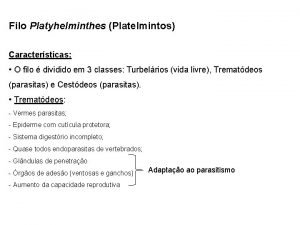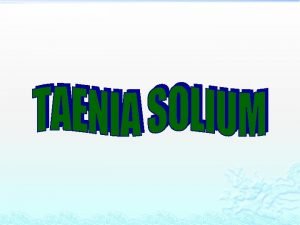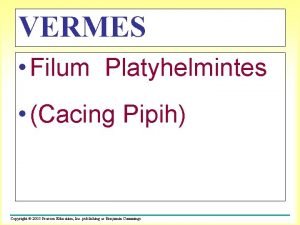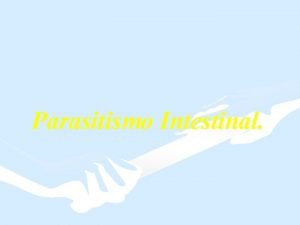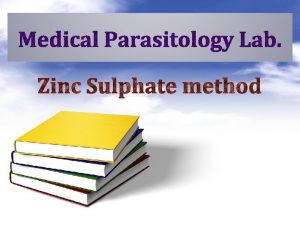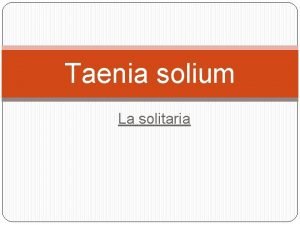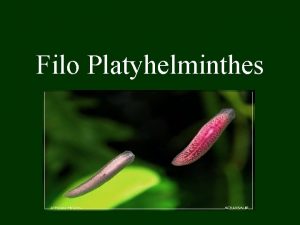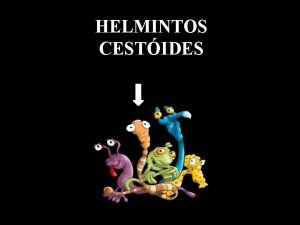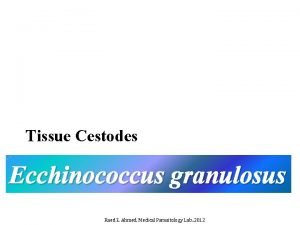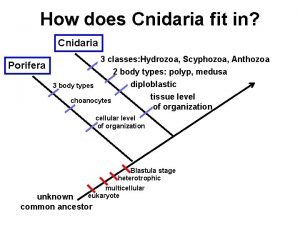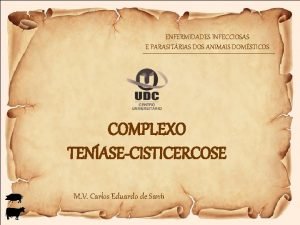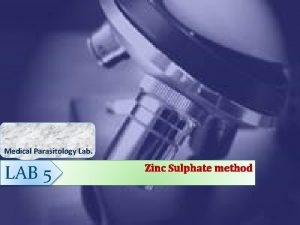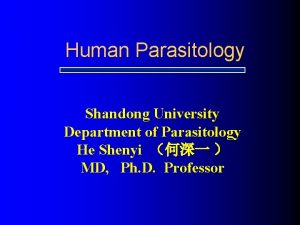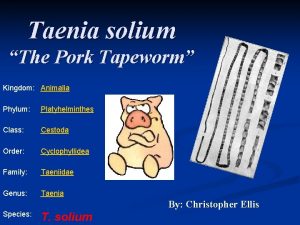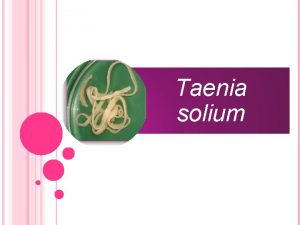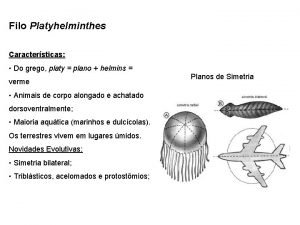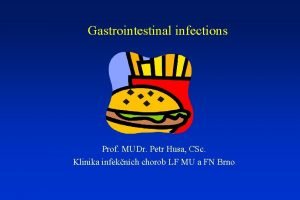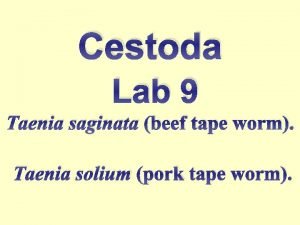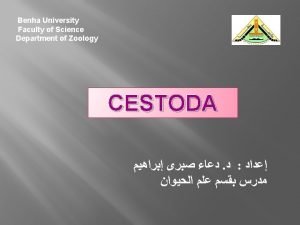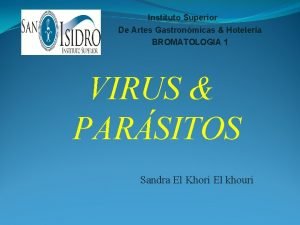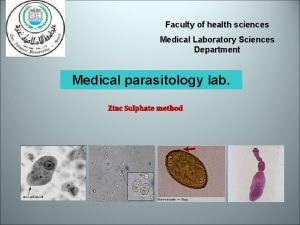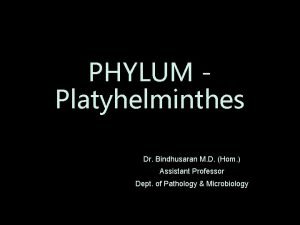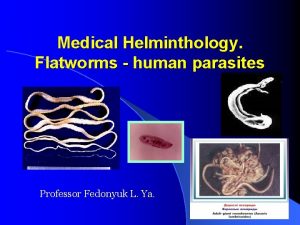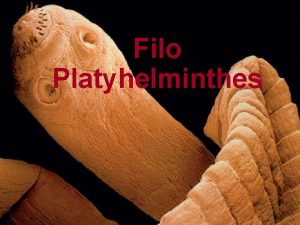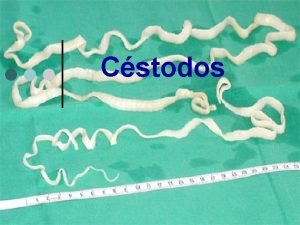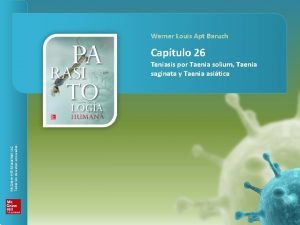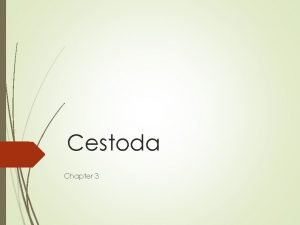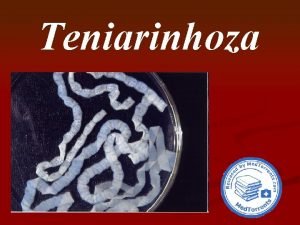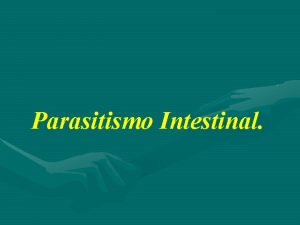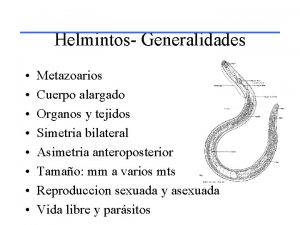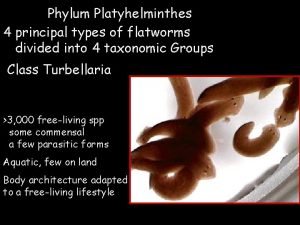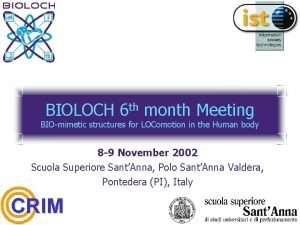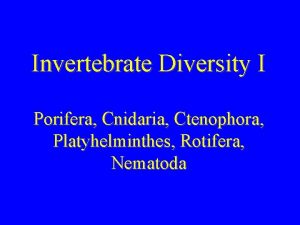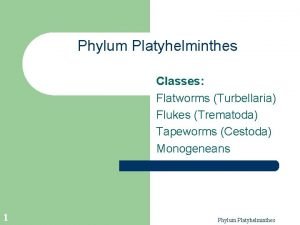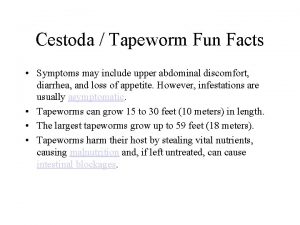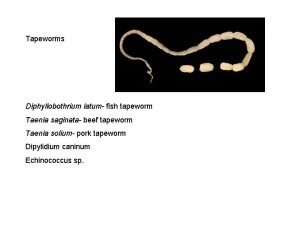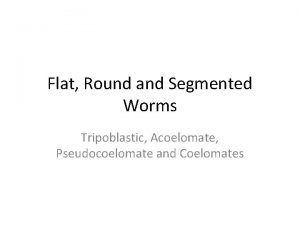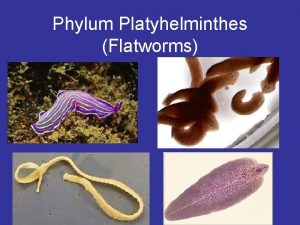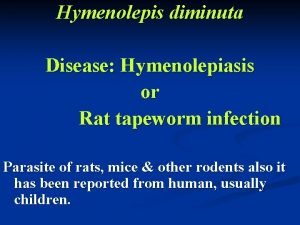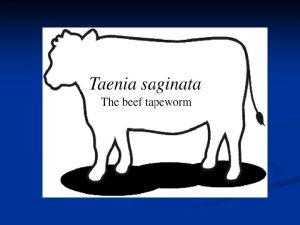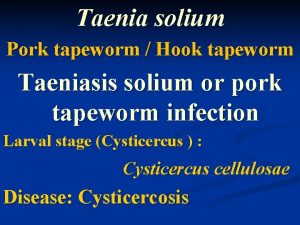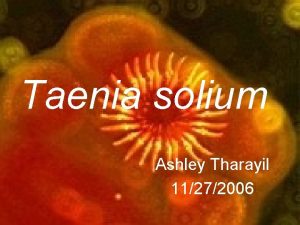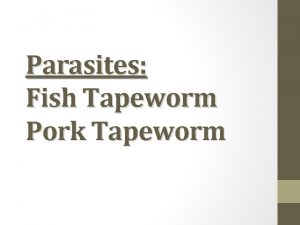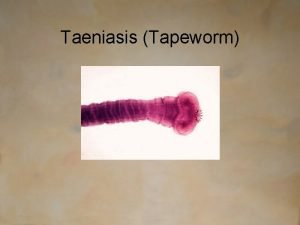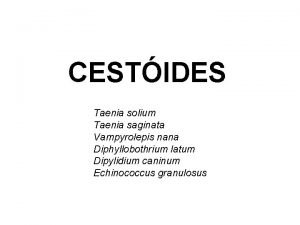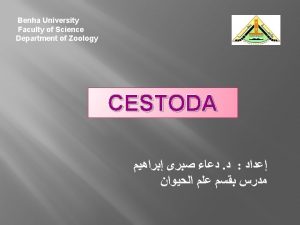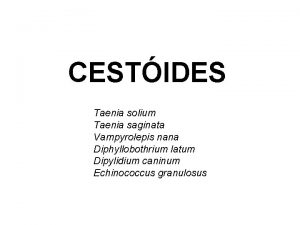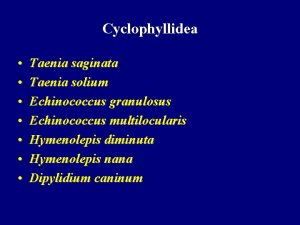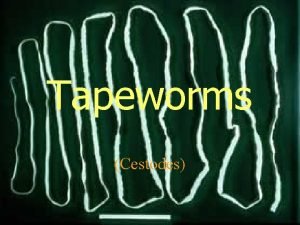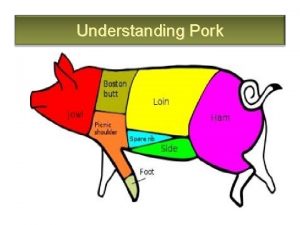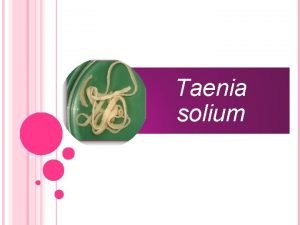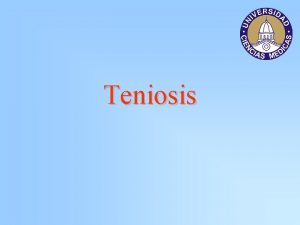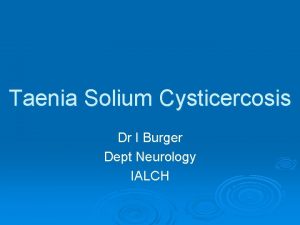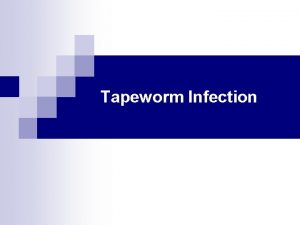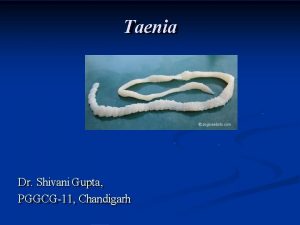Taenia solium v the pork tapeworm producing taeniasis














































- Slides: 46


Taenia solium v the pork tapeworm producing taeniasis solium or pork tapeworm infection

Distribution v Cosmopolitan distribution Countries: Mexico Pakistan Latin America India North China USA (rare) Manchuria v Associated with eating raw or insufficient cooked pork

DISEASES: (Classification) a. Taeniasis solium – refers to infection of humans with adult pork tapeworm while b. Human cysticercosis - refers to infection of humans with larval stage of parasites

Etiology: a. Taeniasis solium * ingestion of raw or insufficiently cooked pork containing cysticercus cellulosae b. Human cysticercosis * ingestion of eggs of taenia solium or thru regurgitation of eggs and gravid proglottids

v Diseases produced by infection with larval taenia solium is not uncommon in regions where Taenia solium adult infection exist

In human cysticercosis: Man becomes the intermediate host.

Morphology: I. Adult worm a. Measurement – 2 -3 meters (exceptionally 8 meters in length) b. Composition 1. Head 2. Neck 3. Proglottids 1. a Immature 1. b Mature 1. c Gravid

Head or scolex Neck

Proglottids or segments 1. Immature proglottids 2. Mature proglottids 3. Gravid proglottids

Head or Scolex v v globular in shaped with 4 cupshaped suckers provided with conspicuous, rounded rostellum armed with a double rows of large and small hooks numbering 22 to 36 and measuring 140 to 200 um and 100 to 150 um in length.

Cervical region or neck v short measuring 5 to 10 mm in length (only about one-half as thick as scolex)

Proglottids or segments A. Numbers : 800 to 1, 000 proglottids B. Composed: a. Immature proglottid - broader than long b. Mature proglottid - nearly square c. Gravid proglottid - longer than broader

Mature Proglottid A. Nearly square B. Composed: 1. Containing full set of functioning male and female reproductive organs 2. 150 to 200 follicles distributed throughout the dorsal plane

Mature Proglottid 3. Uterus – rises from the anterior face of ootype 4. Trilobed Ovary – situated in the posterior of the proglottid with the presence of accessory ovarian lobe

Mature Proglottid 5. Half as many testes as T. saginata 6. Genital pores on consecutive segments

Gravid Proglottid - longer than broader - consists: a. common genital pore with muscular sphincter b. gravid uterus with 5 to 13 lateral uterine branches arranged in a Dendritic or finger like fashion

Egg a. Shape – spherical Color - pale buff to walnut brown Measurement – 5 to 10 um in diameter

b. consist: - 2 radially-striated shells 1. Outer shell – thin and rarely seen 2. Inner shell – brown, thick and striated * embryo or oncosphere with six hooklets

v Eggs escape from the uterus through the ruptured wall at the anterior end after the ripe proglottids become free

LARVAL STAGE OR BLADDER WORM v also called as Cysticercus cellulosae v. Measurement – 5 to 10 mm in length and 5 mm in diameter v Consists – dense milky white spot at one where the invaginated scolex with hooks and suckers are located

Life Cycle: TAENIA SOLIUM Adult worm attaches to the mucosa of small intestine by means of scolex Gravid segments can either be a) Detached by apolysis and moved out of the anus b) Discharged with feces Pigs ingest gravid segments or eggs while feeding with human feces Cysticercosis develop in pig’s muscle and other tissues Man ingested raw or insufficiently cooked pork containing cysticercus giving rise to Taeniasis solium Man may accidentally acquire the egg thru external autoinfection develop human cysticercosis

LIFE CYCLE OF TAENIA SOLIUM

LIFE CYCLE OF TAENIA SOLIUM Scolex evaginates and attaches to the intestinal mucosa Adult worm in small intestine Gravid segments and/or eggs discharged with feces; segments liberate eggs Man may ingest eggs and cysticercosis cellulosae may develop in man Infected pork Ingested (raw or Insufficiently cooked) Cysticercus cellulosae (Infective stage) in muscle tissue of the pigs Pigs ingest gravid segments or eggs

LIFE CYCLE OF HUMAN CYSTICERCOSIS

Human being harbor cysticercus cellulosae: 1. Hetero infection – eggs liberated from disintegrating gravid proglottides passed by one individual get into the mouth of another and are swallowed 2. External autoinfection – eggs maybe transferred from anus to mouth or unclean fingertips of an individual who has an intestinal infection with Taeniasis solium.

3. Internal autoinfections – gravid proglottids in an individual harboring the adult Taenia solium may become detached from the main strobila or regurgitated into the stomach and then return to duodenal canal where they disintegrate and liberate ripened eggs.

PATHOLOGY AND CLINICAL MANIFESTATIONS 1. Pathology brought about by adult taenia solium in lumen of the small intestines maybe negligible.

SYMPTOMS: a. Mild transitory intestinal obstruction b. Vague abdominal pain similar to hunger pain which is due to heavy cysticercosis resulting to regurgitation of gravid segments in to the stomach of patients suffering from taeniasis solium

2. Pathology brought about by larval stage (cysticercus cellulosae) - serious, because it may lodge in vital organs like brain, spinal cord, heart, liver and the eyes

Symptoms: a. Cellular reactions b. Blood cell infiltration c. Fibrosis d. Necrosis

Cysticercosis in the brain may cause: a. epilepsy b. behavioral changes c. intermittent obstructive hydrocephalus d. dysequilibrium e. meningoencephalitis f. failing vision

Cross section of Cysticercus cyst in Human muscle

Cysticercosis of Brain

Single cysticercus of T. solium (Left cerebral cortex)


Section of eye with a single Cysticercus of Taenia solium

DIAGNOSIS I. Demonstration of eggs in stool a. Direct fecal smear b. Scotch tape swab * Taenia spp. differentiation is not possible through eggs examination

2. Demonstration of gravid proglottids in the stool. 3. Recovery of scolex after antihelminthic therapy

Species differentiation: T. Solium and T. saginata can be made possible thru: A. Scolex: T solium – has rostellum armed with spines or hooklets T. saginata – no well defined rostellum nor spine

B. Segment differentiation 1. Segments: T. solium – 800 -1000 segments T. saginata – 1000 -2000 segments 2. Lateral branches: T. solium have less than 13 lateral uterine brandches T. saginata have more than 15 lateral uterine branches

Epidemiology I. T. solium infection v Prevalence of infection is directly related to eating habit of people (raw or insufficient cooked pork) v Man is the only known definitive host and the pig appears to be the only intermediate host

Human cysticercosis A. Man become the intermediate host B. Can be caused by: a. ingestion of eggs from contaminated food or water b. contamination from dirty fingers c. by internal autoinfection when the eggs are carried by reverse peristalsis back to the duodenum or stomach

TREATMENT, PREVENTION AND CONTROL TREATMENT v Praziquantel Dosage: 10 to 20 mg per kg single dose Effect: expel worm in toto v Niclosamide ) Disadvantage - causes v Paromomycin ) the proglottids to rupture and releases innumerable eggs into the bowel lumen and increase risk of cysticercosis.

II. PREVENTION AND CONTROL v Taeniasis solium - Avoid eating raw or insufficiently cooked pork - Proper excreta disposal

v Human cysticercosis - Good personal hygiene - Avoidance of drugs which causes distingration of gravid segments
 Taenia solium filo
Taenia solium filo Proglottids of taenia saginata
Proglottids of taenia saginata Taenia solium
Taenia solium Siklus hidup cacing pita
Siklus hidup cacing pita Taenia saginata huevo
Taenia saginata huevo Zinc sulphate centrifugal flotation technique
Zinc sulphate centrifugal flotation technique Tenia reino
Tenia reino Cefalização
Cefalização Taenia solium
Taenia solium T solium
T solium Taenia solium class
Taenia solium class Stomoxys calcitrans.
Stomoxys calcitrans. Taenia solium filo
Taenia solium filo Zinc sulphate technique in parasitology
Zinc sulphate technique in parasitology Facultative parasite
Facultative parasite Taenia solium
Taenia solium Morphology of taenia solium
Morphology of taenia solium Platelmintos características
Platelmintos características Autoinfection in taenia solium
Autoinfection in taenia solium Cestoda partes
Cestoda partes Taenia solium egg
Taenia solium egg Taenia saginata phylum
Taenia saginata phylum Ekskrecioni sistem
Ekskrecioni sistem Anikasis
Anikasis Taenia solium
Taenia solium Taenia saginata phylum
Taenia saginata phylum Taenia solium has proglottids with 17-35 uterine branches.
Taenia solium has proglottids with 17-35 uterine branches. A taenia solium
A taenia solium Taenia solium
Taenia solium Taenia solium
Taenia solium Life history of taenia solium
Life history of taenia solium Taenia saginata phylum
Taenia saginata phylum Parsito
Parsito Parasito taenia solium
Parasito taenia solium Dioecious
Dioecious Bioloch
Bioloch Taenia solium class
Taenia solium class Taeniasis
Taeniasis Biology relationships
Biology relationships Platyhelminthes classes
Platyhelminthes classes Tapeworm fun facts
Tapeworm fun facts Diphyllobothrium latum
Diphyllobothrium latum Beef tapeworm
Beef tapeworm Annelida acoelomate
Annelida acoelomate Is platyhelminthes acoelomate
Is platyhelminthes acoelomate Hymenolepis nana life cycle
Hymenolepis nana life cycle Hookless tapeworm
Hookless tapeworm
